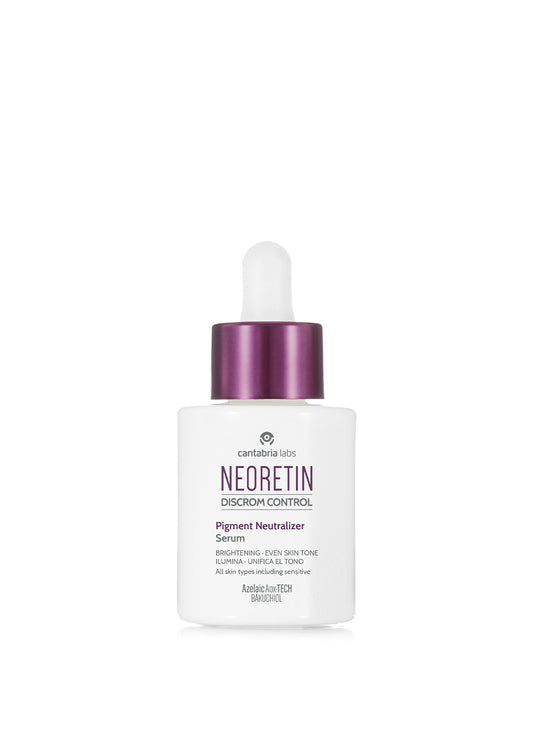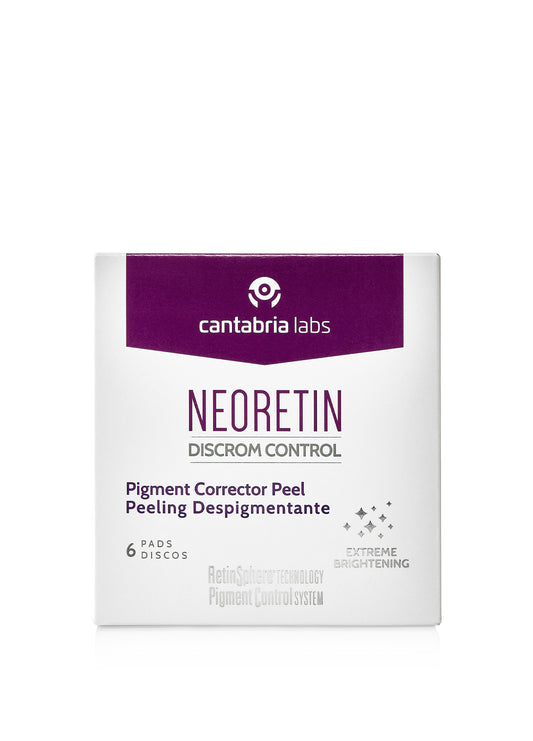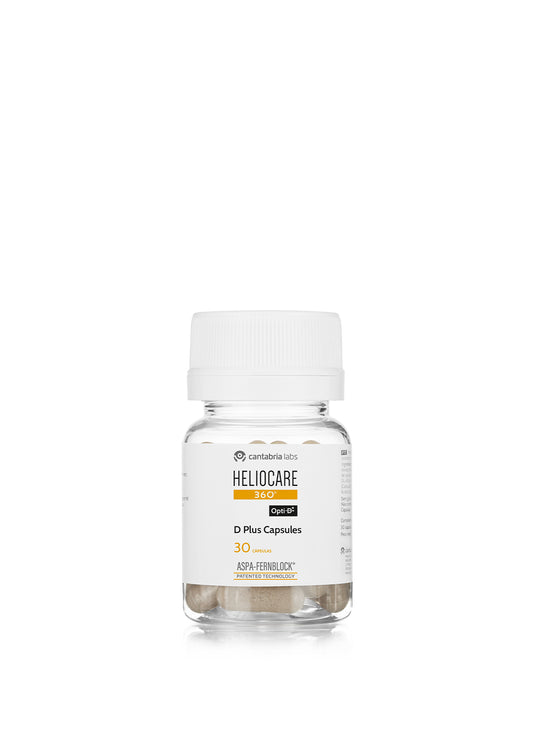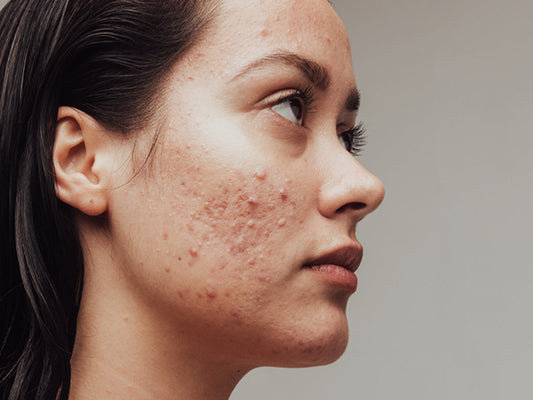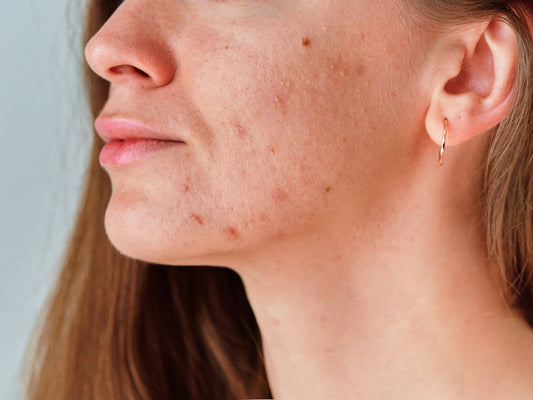What causes hyperpigmentation & how to treat it effectively
Published on 13 August 2025
Hyperpigmentation is one of the most widespread skin concerns, experienced by people of all ages and skin types, although some skin tones suffer more. Hyperpigmentation is typically harmless, but it can be a sign of deeper skin damage.
What is hyperpigmentation and how does it develop?
Hyperpigmentation occurs when there’s an overproduction or irregular distribution of melanin in the skin. This makes patches of skin become darker than the surrounding area.
Melanin is the pigment that determines the colour of our skin, hair and eyes. It exists within melanocyte cells, which are evenly scattered deep in the basal layer of skin1. Sometimes, melanin gathers in small spots or patches, which is what causes freckles. Everybody has the same number of melanocyte cells in their skin, but we all produce different amounts of melanin. People who produce higher amounts of melanin have darker skin tones. Those who produce less melanin have lighter skin.
There are a number of triggers that increase melanin production beyond what is normal for our bodies. These include UV radiation, trauma, inflammation, hormonal changes, medications and certain health conditions.
Hyperpigmentation manifests in a few different ways:
Melasma
Melasma is a common condition where brown and grey-brown patches appear on the face, most often on the cheeks, chin, forehead, nose bridge and upper lip. It is often triggered by hormonal changes, such as pregnancy or oral contraceptives. Other triggers include UV radiation, medication and cosmetics, along with genetic influences.
Melasma is more common in females than males. Approximately 50% of people with melasma report a family history of the condition2. It is also more likely to appear on light-brown skin types.

Post-inflammatory hyperpigmentation
Post-inflammatory hyperpigmentation (PIH) can occur after the skin experiences injury or inflammation. This trauma leads to an overproduction of melanin, which causes dark spots. Inflammatory skin conditions may lead to PIH. This includes acne, which is a leading cause. Injuries like cuts, burns, rashes and insect bites can also result in PIH. It is something that should always be considered after professional skin treatments, such as chemical peels and laser, as the skin undergoes trauma and inflammation.

Sun spots
Sun spots, also known as solar lentigines, are caused by cumulative sun exposure. They are benign lesions on the skin, appearing as flat brown spots. They typically appear after the age of fifty, most often on sun-exposed areas like the face, neck, chest, forearms and hands - areas that are regularly exposed to the sun3.

Who gets hyperpigmentation, and why?
Skin pigmentation and melanin synthesis differs from person to person, which means hyperpigmentation can affect anyone. However, there are factors that make people more prone to developing the condition. It is most common and noticeable in those with medium to dark tones, such as people of African, Asian or Mediterranean descent. This is because darker skin types have more active melanocytes, the cells that produce melanin, which makes the skin more reactive to hyperpigmentation triggers.
Women are more likely to experience hyperpigmentation because of hormonal shifts, particularly pregnancy. Melasma is often referred to as ‘the mask of pregnancy’, because it is so common, especially in the second and third trimesters. The exact mechanism of melasma in pregnancy is still unknown, but it is thought to be triggered by a combination of hormonal factors (such as the increase of estrogen, progesterone and melanocyte-stimulating hormones), UV exposure and genetic influences4.
Individuals who suffer from inflammatory skin conditions, including acne, eczema, psoriasis and dermatitis, are more likely to experience hyperpigmentation. This is because their skin more regularly undergoes trauma from flareups. Certain skincare ingredients can also worsen the appearance of hyperpigmentation.
Finally, people who spend a lot of time in the sun will also be at a higher risk of developing dark spots and an uneven skin tone.
How sun exposure can cause hyperpigmentation
When the sun’s rays hit our skin, our melanocyte cells immediately realise there’s a risk of damage. To protect the skin, they start to produce more melanin, which helps to absorb UV rays. Prolonged sun exposure produces a high level of melanin, which is what leads to a suntan and the darkening of existing hyperpigmented areas. It can also produce an uneven amount of melanin, which makes the skin tone look irregular. The more time spent in the sun, the more melanin that accumulates, leading to long-term skin discolouration.
UV radiation is a well-known cause of hyperpigmentation, but other forms of solar radiation are also responsible. Visible light, particularly high-energy visible light (HEV) and blue light, can worsen the look of pigmentation.
So how can we best treat existing areas of hyperpigmentation? And how can we protect our skin to prevent new dark patches forming?
The best skincare ingredients for hyperpigmentation and dark spots
Retinol
Retinol, a form of vitamin A, is one of the most powerful anti-ageing skincare ingredients. In terms of hyperpigmentation, retinol can help to prevent the production of melanin enzymes, which slows down the development of new dark spots. It also promotes skin cell turnover, reduces fine lines and wrinkles, and enhances the skin’s overall radiance.
RetinSphere® Technology
RetinSphere® is a patented retinoid complex that offers retinol in two forms: hydroxypinacolone retinoate (HPR), and retinol encapsulated in glycospheres and microsponges. The two powerful, high-tolerance retinoids are delivered to the skin in a dual delivery system, providing both immediate and sustained release for maximum efficacy and minimal irritation. Here, RetinSphere® Technology promotes skin cell turnover and reduces the appearance of dark spots for a bright and even complexion.
Azelaic Aox-TECH
Azelaic Aox-TECH features a patented delivery system that boosts the action of azelaic acid up to five times. Packed with antioxidants, it helps to protect skin from environmental aggressors and offers incredible efficacy in exfoliating, unifying the skin tone, reducing pigmentation and soothing the skin.
Hyaluronic acid
Hyaluronic acid is one of the best active acids for hyperpigmentation, as it promotes skin cell turnover and retains moisture in the skin. This helps to hydrate and plump the skin, reducing fine lines and enhancing elasticity, whilst improving the look of pigmentation.
Bakuchiol
Bakuchiol is a potent antioxidant that targets skin discolouration and brightens the complexion. By boosting collagen production, it also helps to reduce signs of ageing, such as fine lines, wrinkles and skin sagging.
Vitamin C
Vitamin C is an incredible skin-brightening antioxidant that helps to lighten areas of discolouration. It also boosts collagen production, making the skin more plump and elastic, as well as reducing signs of ageing.
Vitamin E
Vitamin E is a potent antioxidant that promotes healing and skin cell regeneration. This helps to gradually lighten areas of hyperpigmentation and create a more bright, even skin tone. Vitamin E will also help to soothe and hydrate the skin, improving its overall texture and reducing the look of blemishes and scarring.
Salicylic acid
Salicylic acid is a beta hydroxy acid (BHA) that helps to exfoliate the skin and clear pores. It is a great ingredient for treating acne and spot-prone skin, but it is also effective for areas of hyperpigmentation, especially PIH. Salicylic acid will promote cell turnover, which fades dark spots and improves the overall skin tone and texture.
Kojic acid
Kojic acid is a natural whitening agent, derived from fungi, which helps to reduce hyperpigmentation and create a brighter, more even skin tone. It works by inhibiting melanin production.
Niacinamide
Niacinamide, or vitamin B3, is a multi-tasking antioxidant that improves skin elasticity and enhances the skin barrier function. It also helps to reduce inflammation and create a more smooth, bright and even skin tone.
Glycolic acid
Glycolic is an alpha hydroxy acid (AHA) that will gently exfoliate the skin, removing dead skin cells, unclogging pores and boosting collagen production. This creates a smoother, healthier complexion and an improved appearance of hyperpigmentation.
Ellagic acid
Ellagic acid is an effective skin-lightening ingredient that helps to tackle dark spots and areas of hyperpigmentation. Its antioxidant properties fight free radicals, preventing excessive melanin production and other forms of skin damage.
ASPA-Fernblock®
ASPA-Fernblock® is an incredible skin bioactive technology featuring the patented plant extracts, Aspalathus linearis (ASPA) and Polypodium leucotomos. It delivers powerful antioxidant protection which helps to prevent and repair sun-induced skin damage. It protects the skin against UVA, UVB, visible light and infrared-A radiation, preventing the formation of new dark spots and preventing existing hyperpigmentation from getting worse. What’s more, ASPA-Fernblock® optimises the skin’s natural vitamin D function and protects the skin’s vitamin D receptors (VDRs) from oxidative stress, ensuring you are getting only the very best from the sun.
Clinically-proven products for hyperpigmentation
Using a combination of the above ingredients will dramatically approve the appearance of hyperpigmentation and dark spots over time, especially when combined with full-spectrum, high-level sun protection.
For the ultimate hyperpigmentation skin care routine, discover NEORETIN, our advanced pigmentation control range powered by RetinSphere® and Azelaic Aox-TECH, along with bakuchiol for skin renewal and hyaluronic acid for super hydration. NEORETIN features advanced retinol and pigment control technologies that help to reduce existing areas of discolouration, whilst preventing the formation of new dark patches. It is clinically proven to improve hyperpigmentation, targeting every stage of the melanin production cycle for a bright, even and healthy complexion.
The NEORETIN range offers two incredible products, the NEORETIN Pigment Neutraliser Serum and NEORETIN Pigment Corrector Peel Pads. The serum is uniquely formulated to tackle pigmentation with minimal irritation, suitable for all skin types, even those who are usually sensitive to retinol and AHAs. Our Pigment Corrector Peel Pads are a weekly peeling system, designed to enhance the results of other depigmentation treatments by promoting exfoliation and skin renewal.

NEORETIN formulations work brilliantly alongside our award-winning sun protection range, HELIOCARE 360°, which helps to tackle hyperpigmentation at source. The range includes a wide choice of sunscreen formulations for all skin types, with the HELIOCARE 360° Pigment Solution Fluid SPF50+ being specifically designed for hyperpigmentation. This light and silky fluid provides full spectrum protection against solar radiation, packed with intelligent ingredients that fight free radicals, support DNA repair and maintain vitamin D function, helping to prevent and reduce hyperpigmentation whilst improving overall skin health.

You can further boost your sun protection with HELIOCARE 360° D-Plus oral sun protection capsules, which are powered by ASPA-Fernblock® to work from within to protect against solar radiation, free radicals and skin damage. The capsules are enriched with further skin-loving ingredients that also reduce hyperpigmentation, and are highly recommended to people who suffer from melasma.

Incorporate these incredible hyperpigmentation skincare solutions into your routine below:
Daily skincare routine for hyperpigmentation treatment
Every morning
- Cleanse the skin with a gentle cleanser.
- Apply the NEORETIN Pigment Neutraliser Serum. Shake, then apply a few drops onto the face, neck and décolleté. Be sure to avoid contact with the eyes. Massage the serum gently until completely absorbed.
- Apply the HELIOCARE 360° Pigment Solution Fluid as the final step. Use approximately two full finger lengths on the face, ensuring that you apply evenly and get full coverage up to the hairline and around the eyes. Reapply every two hours during periods of high exposure, or after sweating, swimming or towelling the skin.
- Take a HELIOCARE 360° D-Plus Capsule at least thirty minutes before you go outside. On days of prolonged sun exposure, take an extra capsule at midday.
Every evening
- Cleanse the skin with a gentle cleanser.
- Apply the NEORETIN Pigment Neutraliser Serum. Shake, then apply a few drops onto the face, neck and décolleté. Be sure to avoid contact with the eyes. Massage the serum gently until completely absorbed.
- Follow with your moisturiser or nourishing nighttime treatment of choice.
Once a week
- Use the NEORETIN Pigment Corrector Peel Pads one evening per week, or as recommended by your skincare specialist. Apply to the face, gently massaging with circular movements, for one minute. Leave the residue overnight, then rinse off in the morning with warm water.
The NEORETIN Pigment Corrector Peel Pads are recommended for use on their own, or in combination with skin lightening treatments or procedures to enhance results.
Consistency is key for treating hyperpigmentation. Remember, the single best way to protect the skin from pigmentation and other effects of sun damage is to protect the skin, every single day, even when it’s not sunny outside. This is particularly important for anybody seeking hyperpigmentation treatment5.
By applying a full spectrum, high level SPF as part of your daily skincare routine, and incorporating intelligent ingredients that target every stage of the melanin production, you’ll help to protect against the formation of hyperpigmentation, improve the appearance of existing dark spots, and notice a more bright, even and healthy complexion.
Limited Time Offer - Complete Your Hyperpigmentation Routine
For a limited time only, you can receive NEORETIN Pigment Neutraliser Serum & Pigment Corrector Peel Pads (worth £70) for FREE when you purchase HELIOCARE 360° Pigment Solution Fluid.

